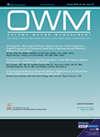一个描述性的,横断面研究评估压疮知识和压疮预防态度护士在尼日利亚三级卫生机构。
Q2 Nursing
引用次数: 12
摘要
在全球范围内,高于预期的压疮率通常被认为是一项医疗质量指标。尼日利亚目前没有关于压疮风险评估、预防和治疗的国家指南。一项描述性横断面研究进行了评估压疮知识和护士对压疮预防在尼日利亚三级卫生机构的态度。在2个月的时间里,招募护士完成25项纸笔调查,包括参与者人口统计信息(6项)、压疮知识问题(11项)和参与者对压疮预防态度的陈述(8项)。数据被手工输入到统计分析软件中,使用描述性统计(频率和百分比)进行分析和呈现。90名护士中,女性60人(占66.7%),已婚45人(占50%),有1 ~ 10年护理经验75人(占83.3%);69例(76.7%)接受过压疮预防专项培训。总体而言,58名(64.4%)护士具有正确的压疮知识,67名(74.4%)护士对预防压疮持积极态度。然而,56名护士(62.2%)不同意对无压疮风险的患者进行定期再筛查,70名护士(77.8%)认为预防压疮应由护士和患者家属共同负责。因此,90名护士中的大多数都知道导致压力性溃疡的因素以及如何预防压力性溃疡,但护士需要认识到,对所有行动不便的患者进行压力性溃疡风险筛查是其工作的一个组成部分,护士对患者及其亲属如何预防压力性溃疡进行启蒙是很重要的。本文章由计算机程序翻译,如有差异,请以英文原文为准。
A Descriptive, Cross-sectional Study to Assess Pressure Ulcer Knowledge and Pressure Ulcer Prevention Attitudes of Nurses in a Tertiary Health Institution in Nigeria.
Globally, higher-than-expected pressure ulcer rates generally are considered a quality-of-care indicator. Nigeria currently has no national guidelines for pressure ulcer risk assessment, prevention, and treatment. A descriptive cross-sectional study was conducted to assess the pressure ulcer knowledge and the attitude of nurses regarding pressure ulcer prevention in a tertiary health institution in Nigeria. During a period of 2 months, nurses were recruited to complete a 25-item paper/pencil survey that included participant demographic information (6 items), pressure ulcer knowledge questions (11 items), and statements on participants' attitude toward pressure ulcer prevention (8 items). Data were entered manually into statistical analysis software, analyzed, and presented using descriptive statistics (frequencies and percentages). The majority of the 90 nurse participants were female (60, 66.7%), 45 (50%) were married, and 75 (83.3%) had 1 to 10 years' experience in nursing practice; 69 (76.7%) had received special training on pressure ulcer prevention. Overall, 58 (64.4%) nurses had correct pressure ulcer knowledge and 67 (74.4%) had a positive attitude toward preventing pressure ulcers. However, 56 nurses (62.2%) disagreed with regular rescreening of patients whom they deemed not at risk of developing pressure ulcer, and 70 (77.8%) believed pressure ulcer prevention should be the joint responsibility of both nurses and relatives of the patients. Thus, the majority of the 90 nurses knew the factors responsible for pressure ulcers and how to prevent them, but nurses need to be orientated to the fact that pressure ulcer risk screening of all patients with limited mobility is an integral part of their job and that it is important that nurses enlighten patients and their relatives on how to prevent pressure ulcers.
求助全文
通过发布文献求助,成功后即可免费获取论文全文。
去求助
来源期刊

Ostomy Wound Management
医学-外科
CiteScore
0.99
自引率
0.00%
发文量
0
审稿时长
>12 weeks
期刊介绍:
Ostomy/Wound Management was founded in March of 1980 as "Ostomy Management." In 1985, this small journal dramatically expanded its content and readership by embracing the overlapping disciplines of ostomy care, wound care, incontinence care, and related skin and nutritional issues and became the premier journal of its kind. Ostomy/Wound Managements" readers include healthcare professionals from multiple disciplines. Today, our readers benefit from contemporary and comprehensive review and research papers that are practical, clinically oriented, and cutting edge. Each published article undergoes a rigorous double-blind peer review by members of both the Editorial Advisory Board and the Ad-Hoc Peer Review Panel.
 求助内容:
求助内容: 应助结果提醒方式:
应助结果提醒方式:


